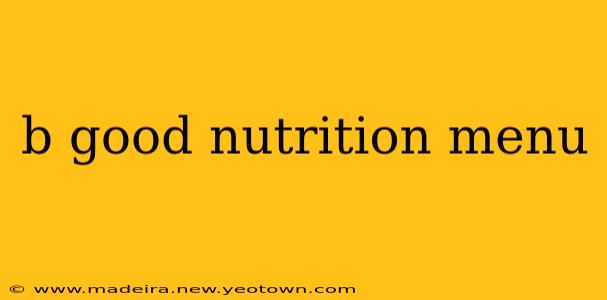Let's be honest, the phrase "good nutrition" can sound a bit… clinical. But good nutrition doesn't have to be bland or boring! It's about fueling your body with the right nutrients to feel your best, and that can absolutely be delicious. This menu focuses on variety, balance, and simple, tasty recipes that anyone can make. We’ll explore how to build a truly satisfying and nutritious eating plan.
This isn't just a menu; it's a journey to understanding how to create your own personalized, delicious, and nutritionally sound meals.
What are the essential nutrients I need?
Before we dive into the menu, let's cover the nutritional basics. A balanced diet includes:
- Protein: Essential for building and repairing tissues. Good sources include lean meats (chicken, turkey, fish), beans, lentils, tofu, and eggs.
- Carbohydrates: Your body's primary energy source. Choose complex carbs like whole grains (brown rice, quinoa, oats), fruits, and vegetables over refined carbs (white bread, sugary cereals).
- Fats: Important for hormone production and nutrient absorption. Focus on healthy fats like those found in avocados, nuts, seeds, and olive oil. Limit saturated and trans fats.
- Vitamins and Minerals: Crucial for various bodily functions. Get these from a variety of colorful fruits and vegetables.
- Fiber: Promotes digestive health and keeps you feeling full. Abundant in fruits, vegetables, and whole grains.
Sample Good Nutrition Menu for a Day
This sample menu provides a balanced intake of macronutrients and micronutrients, but remember to adjust portion sizes based on your individual needs and activity level.
Breakfast (approx. 400 calories):
- Overnight Oats: ½ cup rolled oats, 1 cup almond milk, ¼ cup berries, 1 tablespoon chia seeds. This is packed with fiber and protein, keeping you full until lunch.
Lunch (approx. 500 calories):
- Mediterranean Quinoa Salad: 1 cup cooked quinoa, ½ cup chopped cucumber, ½ cup chopped tomatoes, ¼ cup crumbled feta cheese, 2 tablespoons olive oil, lemon juice to taste. This offers complex carbs, healthy fats, and protein.
Dinner (approx. 600 calories):
- Baked Salmon with Roasted Vegetables: 4oz salmon fillet, 1 cup roasted broccoli and carrots. Salmon is rich in omega-3 fatty acids, while the roasted vegetables provide essential vitamins and minerals.
Snacks (approx. 200 calories total):
- Apple slices with almond butter.
- Handful of almonds and a small orange.
This menu can be adapted to your taste and dietary needs. Feel free to swap out ingredients based on what you enjoy and what's available.
How many calories should I eat per day?
This is a highly individualized question. Your caloric needs depend on factors such as your age, sex, activity level, and overall health goals. Consulting a registered dietitian or using a reputable online calorie calculator can help you determine your personal needs.
What are some healthy recipes for weight loss?
Weight loss is primarily about creating a calorie deficit. The menu above is a good starting point, but you can further refine it by focusing on lean protein, plenty of vegetables, and limiting added sugars and unhealthy fats. Many online resources offer delicious and healthy recipes specifically designed for weight loss. Remember that sustainable, gradual weight loss is healthier than crash dieting.
How can I create a balanced meal plan?
Creating a balanced meal plan involves incorporating all food groups in appropriate proportions. Aim for a variety of colorful fruits and vegetables, whole grains, lean protein, and healthy fats. Consider using the plate method: fill half your plate with non-starchy vegetables, a quarter with lean protein, and a quarter with whole grains.
What are some quick and easy healthy meals?
Busy schedules don't have to mean sacrificing healthy eating! Quick and easy options include:
- Salads: A quick base of greens with your favorite protein and vegetables.
- Stir-fries: Use pre-cut vegetables to save time.
- Overnight oats: Prepare these the night before for a grab-and-go breakfast.
- Smoothies: Blend fruits, vegetables, and protein powder for a nutritious and convenient meal or snack.
Remember, this is a starting point for creating a good nutrition menu tailored to you. Listen to your body, experiment with different foods, and don't hesitate to seek professional guidance from a registered dietitian or nutritionist for personalized advice. Enjoy the delicious journey to better health!

